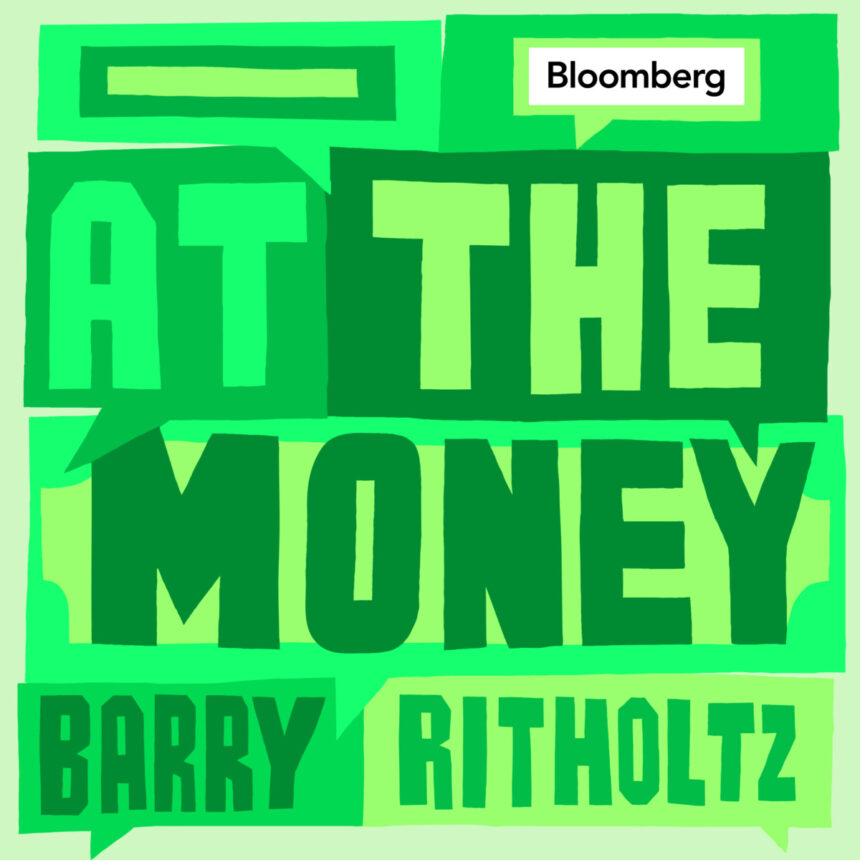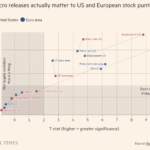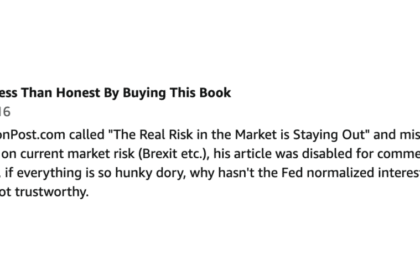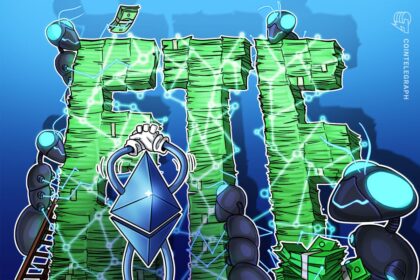At The Money: How Big Can Active ETFS Get? (Dave Nadig , October 22, 2025)
Full transcript below.
~~~
About this week’s guest:
Dave Nadig is President and Director of Research at ETF.com, and he shares with us how investors should navigate all of these new products. Dave helped design and market some of the first exchange-traded funds. He is the author of “A Comprehensive Guide to Exchange-Traded Funds” for the CFA Institute.
For more info, see:
~~~
Find all of the previous At the Money episodes here, and in the MiB feed on Apple Podcasts, YouTube, Spotify, and Bloomberg. And find the entire musical playlist of all the songs I have used on At the Money on Spotify
TRANSCRIPT:
Intro: Pump it up, When you don’t really need it. Pump it up, Until you can feel it
When we think about ETFs, we tend to think about large, cheap passive indexes. After all, those are the biggest ETFs from places like BlackRock, Vanguard, and State Street.
But when we look at all the new ETF launches, they tend to not be passive indexes, not be cheap, and not come necessarily from those three big companies. They’re active and they are involved in all sorts of different areas, that are off the beaten path.
To figure out what this means for you and your portfolio, let’s bring to figure out what this means for your portfolio. Let’s bring in Dave Nadig. He is the President and Director of Research at ETF.com and an ETF structural expert, really since the inception of the entire sector.
Dave, we’ve seen an explosion in the growth of not just new ETFs, but primarily active ETFs in all sorts of niches. What are you seeing in this space?
Dave Nadig: Well, you know, for a long time ETF meant cheap index, right? I mean you go back to SPY and then the first iShares products, and then even when we started getting into the big expansion of the two thousands, it was all just index, index, index. Then we got some smart beta where we tried to be a little bit more clever and it wasn’t really until the late 2010 cycle where Kathy Wood at Ark Invest, launched ARKK and really put herself out there as the portfolio manager in a way that I don’t really frankly remember seeing since the dot-com boom, right?
It’s been a long time since we’d had superstar managers on CNBC talking about, you know, pounding the table for a single stock. And Kathy did that and obviously had enormous amounts of success, has had some performance hiccups along the way, but that sort of went a little bit dormant during some of the pandemic when people really discovered trading.
What we’ve seen now is this resurgence – particularly to folks I’d mentioned Dan Ives Wedbush, people know him; and Tom Lee from Fundstrat with his Granny Shots ETF, both of which have pulled in huge money,
Barry Ritholtz: Billions of dollars?
Dave Nadig: Billions and billions of dollars. And for the reasons you would expect because you’ve got smart people talking on podcasts and TV and on their own air and their own newsletters telling you why they own what’s in the fund. I know that sounds so dumb, but that’s why people love superstar managers because they can look and they can see Tom Lee on screen and he can sit there and say, yeah, this is why we like Bitcoin here. Here are the three firms we have in our fund because of it. We might be wrong, we might be right.
There’s a level of authenticity to that that I think is really appreciated. I also think the fact that they’ve doubled the S&P this year doesn’t hurt.
Barry Ritholtz: So to put some flesh on the bones here, Kathy Woods during 2020 was a huge Tesla and Bitcoin bull. The fund arc put up giant numbers, triple digit gains. Dan Ives has been an apple and an Nvidia bull, pretty much for as long as I can remember. He’s been a whole lot more right than wrong, and Tom Lee has been very constructive exactly when it paid to be constructive and stay bullish.
All three of those managers have really big followings. What does the resurgence of brand name active managers mean for the ETF space?
Dave Nadig: Well, first of all, I think it’s great for the ETF space because I think the dichotomy that we’d had where people thought of active as being a thing that happens somewhere else and ETFs were only passive, wasn’t helpful. I think we are moving towards a world where all of your exposures, for the most part are gonna be in an ETF wrapper. So by all means we should get active managers as part of this mix. And now we’ve got lots of them. You know, we’ve got a bunch of active funds from PIMCO was early, we’ve got lots in the bond space. You know, everything from Cumberland advisors to State Street with the double line and, and Jeff Gundlach. Lots of active managers in lots of different areas. I think that’s very healthy for the industry.
For the individual investor, it doesn’t necessarily make your life easier because as much as I happen to, like all the people we have talked about, Dan, Dom Lee and Kathy – personally as people I would have dinner with, the math is not on their side as an industry, right?
Barry Ritholtz: Why is that?
Dave Nadig: As an industry, we have to point out active managers categorically underperform over time. Doesn’t mean they all do, but it means that you’ve gotta be the special person who managed to pick the right active manager at the right time. That is a tough business and even the active managers running these funds will tell you trying to time when to get in and out of their own funds is gonna be tough. So that’s the problem is
that active management is tough to evaluate.
Barry Ritholtz: Yeah, and to put some numbers there, half of all active managers underperform in any given year. You go out to 10, five years, it’s 80% underperform; at 10 years it’s 90%. So it’s a tough road to hoe
But let’s talk about what makes active ETFs somewhat different than active mutual funds. And that data I referenced where all mutual fund data, mutual funds have to do a regular filing each quarter about their largest holdings, there has been a lot of back and forth about
how transparent active ETFs have to be versus other active funds. What’s the state-of-the-art today? What is the regulatory environment?
Dave Nadig: So there are solutions if you’re an active manager and you don’t want to tell everybody what you’re doing every day. There are solutions and there’s plenty of funds that have been launched on them. Fidelity has their versions. T Rowe Price has been one of the more successful funds out there. They have a pretty popular blue chip strategy called T Chip, which isn’t semi-transparent, meaning they’re not telling you the whole portfolio every day. They’re telling you once in a while and they’re giving the street just enough information to make a good market, not knowing all the information. So it’s sort of a, a clue, a bit of a hack to be semi-transparent.
This solves a problem for some asset managers. It doesn’t solve a single problem for an individual investor, right? So like I’ve never heard an individual investor say, golly, I wish I knew less about what I owned. Right?
Barry Ritholtz: Let’s talk about why it’s a problem for fund managers. Fund managers don’t buy a stock on a Monday and then they’re done. If they say, “Hey, we like XYZ, they’re buying that stock trying to take advantage of drawdowns buying it over days, weeks, even months. So there is a price advantage to the investor if the fund manager can be a little less transparent. Fair, fair description.
Dave Nadig: That’s the, that’s certainly the argument that the active management industry who does not wanna disclose what they’re doing would give you.
So you have articulated that side of the argument. Well, my counter to that would be if your strategy requires you buying securities where your action is going to move the market absent disclosure or absent, you know, obfuscation, then that strategy probably doesn’t belong in an ETF because you’ve got bigger problems, right? That means that you are in something small or a liquid or micro cap, at which point already, my question would be how do you plan on running a $10 billion ETF with that strategy?
Because you can’t really close an ETF. So if you are a special situations manager, if you are a really sort of obscure nichey finding those stocks, nobody else knows about manager, you do not belong in the ETF industry. I’ll just flat out say it as simple as that. The mutual fund structure or even better, a liquidity cap structure like a CEF or an interval fund is actually a better structure for those kinds of investments. Everybody else, CEF, honestly there’s so much liquidity. I think it’s tough to argue that somebody like Tom Lee is being particularly hurt by being transparent. He’s double, he’s at 30% for the year. The S&P500 is up 15%
Barry Ritholtz: CEF stands for closed end funds as opposed to ETFs.
Dave Nadig: Yes.
Barry Ritholtz: So, let’s talk about some other varieties of active funds that are a little bit out there. We see funds with options, futures, derivatives, inverse leveraged, and along with some wild income promises in an ETF wrapper. Tell us about some of those products.
Dave Nadig: Yeah, the, the interesting thing about those is most of them are very mechanical, right? So if you’re running a leveraged strategy, you’re not making any decisions, right? I’ve got Apple, I need 2X Apple, I’m gonna go to my swap counterparty overnight and they’re just gonna settle up my two x swap. That’s the whole management process.
But technically that’s gonna be an actively managed fund because you can’t just automate that whole process. Somebody still has to make a call about whether or not you’re teeing up the swap at this rate or that rate.
Same thing with almost anything in the option space, because the options are constantly changing and constantly repricing and constantly rolling off. It’s very difficult to create solid index product around actively or high frequency moving positions in the options market. So for convenience as much as anything, almost all of those type products you mentioned are listed as active products.
I refer to them as AiNOs — Active in Name Only, because they’re really, there’s no Tom Lee saying I really want Apple options today. There’s some guy generally Jay, pastor Elliot at title, sitting on a desk somewhere pushing a button to say yes, we want those options because the model says we need to roll. And that becomes active management.
And consequently, I mean it is active management, it has higher costs associated with it for a reason. Some of that is the profit that the issuer wants, but some of it is legitimately you need a trading desk with a bunch of people doing work.
Barry Ritholtz: So let’s talk about another niche. Illiquid alts, things like private equity, private credit, private debt, real estate. Are we gonna see those asset classes that really don’t trade on their own — because they’re not public – are we gonna see those in an ETF wrapper?
Dave Nadig: We’re starting to, we’re starting to the, the canary in the coal mine here was some products from State Street, the big ones, priv, PRIV for private, which has a bunch of Apollo private credit in it. Generally pretty short maturity stuff, two, three year kind of things and, and fairly straightforward, understandable private credit. Intel needs to bill a fab in Ireland. They go get a loan, Apollo gives ’em the loan, you get a slice of it.
Nothing super complicated, nothing super interesting either. I mean, it’s not, you’re not getting 20% yields out of or anything like that. You’re getting some marginal increase in the yield you would get if you were simply investing in say, junk or short term co corporates.
So those products are starting to come to market. The concerns I have about them is they’re just gonna be untested. We’re not gonna really know how they’re going to perform when the markets go hinky, right?
And, and also what does that even mean? Like if we had a corporate bond blowout and we saw a bunch of triple C stuff start defaulting, I have no idea what the impact on Apollo private credit issued in Ireland to Intel is going to be when that happens.
I also have no idea how they’re gonna respond if half the fund decides they want out on that Tuesday and now you’ve got a bunch of illiquid stuff, which can be up to 35% of the portfolio that literally the only buyer is Apollo.
Technically they’ve got answers to all those questions. I’m, and I read all the answers to those questions and I’m sort of not convinced, but it’s one of those things that if you wanna be, if you wanna be out there on the edge, by all means go ahead. But I think the private securities in the daily liquid vehicle has not really been through the ringer yet, so I remain very skeptical.
Barry Ritholtz: So let’s talk a little bit about crypto and, and how that’s going to impact in both investor behavior and portfolio construction. Last year, BlackRock, was it last year or this year, BlackRock introduced IBIT. 2024. So it’s a year ago coming up on a 100 billion dollars in assets, probably the fastest ETF ever to do that. What does this mean? And explain the concept of tokenization.
Dave Nadig: Yeah, so what it means is all of these assets are going to be more and more available to the average Joe like us who’s just trading in their Schwab account or something like that. And because the SEC has said they’re gonna make it very easy very soon, we’re gonna have every major coin that people know about a Solana and Avay whatever. There’ll be a sleeve of that in an ETF that you’ll be able to trade. That’s all great.
Then having those building blocks is awesome, also because it will now allow portfolio managers to create portfolios of those individual securities, which right now you can’t even do, you can’t even buy an index right, of the top 10 coins because there isn’t a target for the top 10 coins to invest in. So that will be fun when we get that, and I suspect you’ll see firms like Bitwise and BlackRock who’ve got some real bonafides in the crypto management space, start bringing pretty institutional active management products there. That’s probably a 2026 side.
Long term though, if we wanna talk 10 years from now, that’s when crypto starts becoming an interesting competitor to the ETF space. I think we will eventually end up in a world where how you move your ownership of Apple around is going to happen. Not by going to the New York Stock Exchange and exchanging ledger entries to move around your Schwab account. Instead, you’re gonna have an actual token. You’ll be able to look at the serial number of it, you’ll be able to put it in a wallet and say, “Oh no, this is worth a hundred shares of Apple.” And that wallet will be able to directly move that security to your wallet without any exchange being part of the process.
Most of it will happen, like crypto happens now on giant exchanges because price discovery. But just like with Bitcoin, I could walk up to you when we could engage in a direct transaction, you’re gonna start seeing that with other securities.
It’s happening more in bonds and real estate now. To do it in equities is gonna require some actual legislation and we don’t make so many laws these days. So that may take some time. Instead, what we’ll do is we’ll wrap a lot of stuff. So you, you’ll probably hear about things like Wrapped Apple and wrapped Cisco and what that’s gonna be is a token that owns the security in some sort of trust pool. That’s a baby step, but that’s what we’ll start hearing first. So be skeptical when people say we’re tokenizing everything ’cause it’s gonna be a decade.
Barry Ritholtz: I had a conversation with Jose Minyana who is the head of wealth strategies at investment Giant BNY (Bank in New York) and he was saying, Hey,
we went from T+3 to T+1, meaning it used to take three days to settle a trade. Today it’s gonna take one day. If we wanna get to T+0, we have to really have confidence in both sides of the transaction. And theoretically, tokenization solves that problem.
Dave Nadig: It does. Although think about how many big transactions in the world that we could be doing easier. We deliberately put breaks on, think about buying a house…
Barry Ritholtz: Wiring money?!
Dave Nadig: BarryRight? So it, there’s, you know, the, there’s escrow, there’s secondary inspection processes, there’s separate contracts around just the intention to buy and sell. So the bigger and more interesting a transaction gets, the less T zero is actually a good idea, right? I mean, I, the, the thing I always say about T zero is, did you really want T zero during the flash crash in 2010? Like, did you really want no recourse for that? That fat fingered billion dollar pennies on the dollar trade? No. You wanted this ecosystem that protects you from a bad actor spoofing something into the system. So we we’re gonna have a lot to evaluate as a market, what we actually want. The idea of slowing down markets has actually gotten a lot of traction, like speed bump markets, things like that, that, that are actually pushing against this idea of instantaneous settlement for anything. I don’t even want instantaneous settlement for my bank account. I like knowing that I’ve got somebody I can call when something goes wrong.
Barry Ritholtz: So, so you’ve written about volatility and liquidity laundering. Explain what this is and are these really gonna be ETFs?
Dave Nadig: They already are, man. So volatility laundering is simply moving volatility from one bucket to another and charging something for the privilege of doing that. Right Now you can buy something like MSTY, which will give you a hundred percent income return on a MicroStrategy position through the magic of options, right? And it creates a synthetic long position. Then it does a synthetic covered call against the synthetic long position, and then it does a whole lot of return of capital to give you your money back and promises you this endless stream of high distributions, a high percentage distributions that is volatility laundering.
Because what you are actually doing is you are trying to sell other people the volatility of MicroStrategy, which is probably not a fantastic idea because it, the vol of all is high in those cases. So you are being the person picking up the, in this case, quarters in front of the steamroll, not the pennies, but you’re still exposed to MicroStrategy collapsing and going to nothing. That volatility laundering is what all of these options strategies are really doing.
Barry Ritholtz: So really to wrap this up, the bottom line is bring the same level of common sense and scrutiny to new ETFs that you would to any financial product.
Make sure you understand what the product is, how it generates gains, the sort of risks you’re incurring, especially with these exotic products — And the costs. Are these products worth spending 75, 100, 125 basis points more than what you would get for a plain vanilla passive index that seems to be dominating the asset allocation space and the space for ETFs? Be smart, be thoughtful, do your homework.
I’m Barry Ritholtz. You’ve been listening to Bloomberg’s at the Money.
~~~
Find our entire music playlist for At the Money on Spotify.











